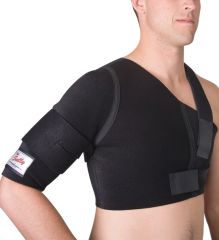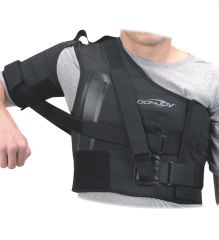Rotator Cuff Tear
The rotator cuff is a group of four muscles that assist in the stability and motion of the shoulder. These muscles attach from the back and underside of the shoulder blade (scapula) and combine to form several tendons that attach to the "ball'" part of the shoulder. When one or more of the tendons in the rotator cuff is torn, this is known as a rotator cuff tear. These tears can be a full or partial tear, and they normally begin with fraying of the tendon.
Causes of Rotator Cuff Tears
Rotator cuff tears can occur over a long period of time as the tendon becomes inflamed from overuse, aging, and repeated minor injuries. Activities requiring repeated overhead arm motion and/or heavy lifting may place excessive strain on the rotator cuff tendon. Tears may also occur suddenly as the result of a trauma such as falling on an outstretched hand or grabbing a heavy weight overhead.
Symptoms of a Rotator Cuff Tear
Rotator Cuff tears may cause some or all of the following symptoms:
- Pain usually over the side and top of the shoulder. Pain is usually worse with overhead and "out-to-the-side" movements.
- Stiffness usually occurs as the pain increases.
- Weakness with movements overhead and 'away-from-the-body'.
- Popping may be present with shoulder motion.
- Loss of Sleep due to pain from lying on the shoulder compressing the tendons.
A physical examination will usually give clues that there is a rotator cuff problem. Unfortunately, a rotator cuff that is severely irritated (but not torn) may have similar symptoms and physical examination findings as a rotator cuff that is torn. X-Rays will show evidence of arthritis and bone spurs, but will only show signs of a rotator cuff tear if it is a very large and has been present for a long time. Therefore an MRI may be ordered to better determine the extent of injury or damage.
How to Treat a Rotator Cuff Tear
You injured your rotator cuff, now what? As with any injury, your doctor will be the best source of advice on the appropriate treatment method for your situation. Rotator cuff tears do not usually `heal' on their own. However, many people do not have severe enough pain, weakness or limited function to warrant surgery. Conservative rehabilitation is often very helpful in this group of patients.
Recovery includes:
- Rest - from activities overhead and 'away-from-the-body'.
- Ice - to help decrease inflammation and pain (especially after activities).
- Anti-inflammatory medications (i.e. Bextra, Celebrex, Ibuprofen, etc.) - to decrease inflammation and pain.
- Cortisone injections - may be used to help decrease pain and inflammation.
- Physical Therapy - to help restore normal motion, strength and function.
Surgical Options
Surgery is indicated for those patients with severe pain, weakness and loss of function who do not respond well to non-operative, conservative treatment. There are several surgical options to treat rotator cuff tears, depending on the size, depth, and location of the tear.
Shoulder Arthroscopy is a 'minimally invasive' surgical procedure in which miniature instruments are inserted through small incisions into the shoulder. Bone spurs scar tissue and most rotator cuff tears can be repaired using arthroscopic techniques.
Open-repair - is used for the most severe cases of rotator cuff tears. Usually an arthroscopy is performed to asses the size and severity of the tear. Bone spurs and scar tissue are removed, and then a small incision is made to allow for a proper repair to the torn rotator cuff.
Following Surgery
These surgeries are all performed on an out-patient basis, meaning you will go home the very same day. You will be given a prescription for pain medication to help control pain, and usually you will have a medication injected into you arm during surgery which will keep your arm numb and pain-free for up to several hours after surgery.
Regardless of the technique used to repair the tear, the recovery usually involves wearing a sling for 2-4 weeks after the surgery to protect the repair. Gentle motion is then allowed for the next few weeks, followed by a physical therapy program designed specifically to restore motion, then strength, and eventually function to the shoulder. The entire recovery may take as long as 6-8 months for full unrestricted activities.
Support and Protection for Rotator Cuff Tear
View All Braces for a Torn Rotator Cuff







